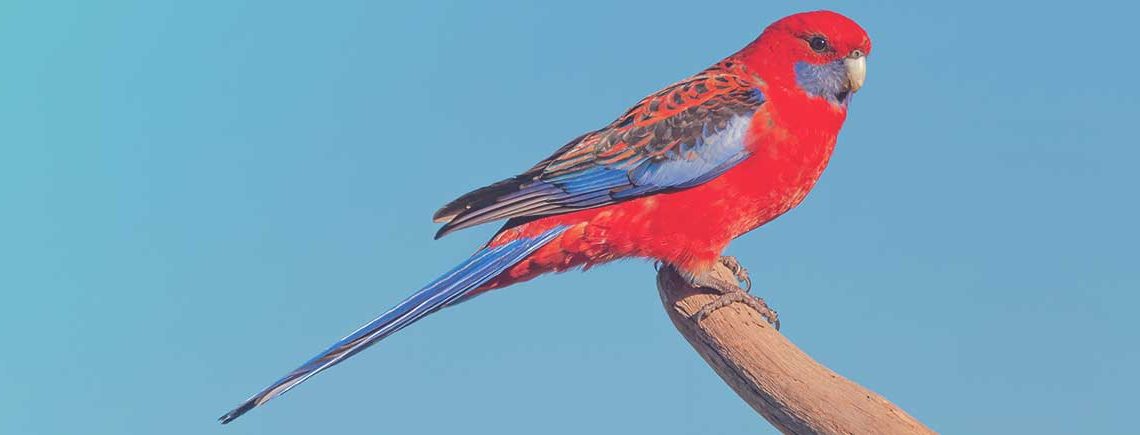Popular Pet Birds – Rosella
Choosing a Pet Bird: A little bit about Rosella
Birds can make wonderful pets, but there are many different types of birds, so how do you choose the one that is right for your family? Like any pet, birds will require lots of love and care to help keep them healthy and well, so in this blog we are taking a look at Rosella, and what you can expect if you were to have a one as a pet.
These birds are happiest in an aviary setting or long flight cages as they are avid flyers. Single pets can be housed in medium-sized parrot cages; as long as they are allocated time out of the cage every day.
Different Types of Rosella
Crimson Rosella
This bird has mostly red feathers with bright blue cheeks and the tail is blue. The feathers at the back of the wings are black. The Crimson Rosella can grow up to fourteen inches long. The female has a smaller head and a finer beak compared to the male crimson Rosella.
Eastern Rosella
It can grow up to twelve inches long, the Eastern Rosella has a red head with white cheeks. The beak is white, with a red upper breast and yellow lower breast. The feathers at the back of the wings are black, with yellow/green patterning. The tail is a dark green colour and the legs are grey. The female is similar to the male, but not as bright in colour.

Company for Rosellas
It is recommended that Rosella birds are not housed with other birds; therefore if you are getting a pair of Rosellas it is best to only keep one pair per aviary. If they are housed in the same aviary (or close by) they will become aggressive towards each other. Similarly, if you have a female Rosella and you are thinking of breeding, it is best to get only one male as they will fight over the female.
Where Rosellas Like to Live
These birds are happiest in an aviary setting or long flight cages as they are avid flyers. Single pets can be housed in medium-sized parrot cages; as long as they are allocated time out of the cage every day.
Males are very much aggressive towards other males, especially in the presence of a hen. If you house pairs separately in side-by-side cages you may want to place solid dividers between them; this will help a great deal with tempering their aggression. It is not advised to house this species with others.
A suitable bedding substance is required, like sand paper or wood shavings. In addition; perches, ropes and bells should be provided in the cage to help occupy the birds.
Exercise & Play
The more you handle your Rosella the tamer it will become, creating a bond between owner and bird. Every bird needs exercise and the Rosella is no different, they love exercise and should be allowed out of their cage every day in order to achieve this. Make sure your house is bird proof before letting the Rosella out (i.e. windows and doors are shut). Toys should be provided for the Rosella.
Handling
Make sure you hold your Rosella gently, do not squeeze or poke it. Let them climb on you and sit on your head if they like. When taking them from their cage, be sure to hold them firmly around their bodies and make sure you don’t bump their heads or beaks. Stroke them gently with the direction of their feathers around their body. If you want your bird to stay tame, you need to handle them at least once a day.
Diet & Nutrition
A good nutritional diet for a Rosella will consist of a variety of seed, fruit and vegetables. The seed can be parrot mix or cockatiel mix, these can both be given to the Rosella along with fresh fruit and vegetables. The seed diet should contain sunflower seed, raisins, buck wheat, hempseed and nuts. The fresh fruit should consist of apples, oranges, and blackberries. Millet can be used as a treat along with a cuttlebone or a mineral block used to add extra nutrients and also maintaining the beak of the Rosella.
Health & Hygiene
Always wash your hands before and after handling your bird, this helps prevent any diseases spreading.
Visible signs of illness in Rosellas:
- Feather plucking
- Plumage looks messy and unkempt
- Plumage loses its former lustre
- Bare spots visible in the plumage
- The Rosella seems lethargic and listless
- It’s sleeps more than normally
- Loss of appetite
- Changed faeces
- The bird sneezes more than just once in a while
- Visible discharge oozing from the nostrils
- Slit eyes instead of round eyes
- Unusual screaming
Take Me Home Checklist
Before you take your Rosella home, you will need make sure you have some things to in order to help keep them healthy and happy. We’ve put together a simple ‘Take Me Home’ checklist for new Rosella keepers. If you have any questions, or need any further advise, please drop in to your local Petmania and talk to our Petcare Advisors.
- Metal parrot cage (aviary for two Rosellas) or long flight aviary
- Bedding (beech chippings or sand paper)
- Food (parrot mix and cockatiel mix, with fruit and vegetables)
- Food and water bowls
- Toys (perches, ropes, bells)
- Bird bath or mist spray
- Cuttlebone or mineral block
- Treats (millet spray)
- Bird safe disinfectant

